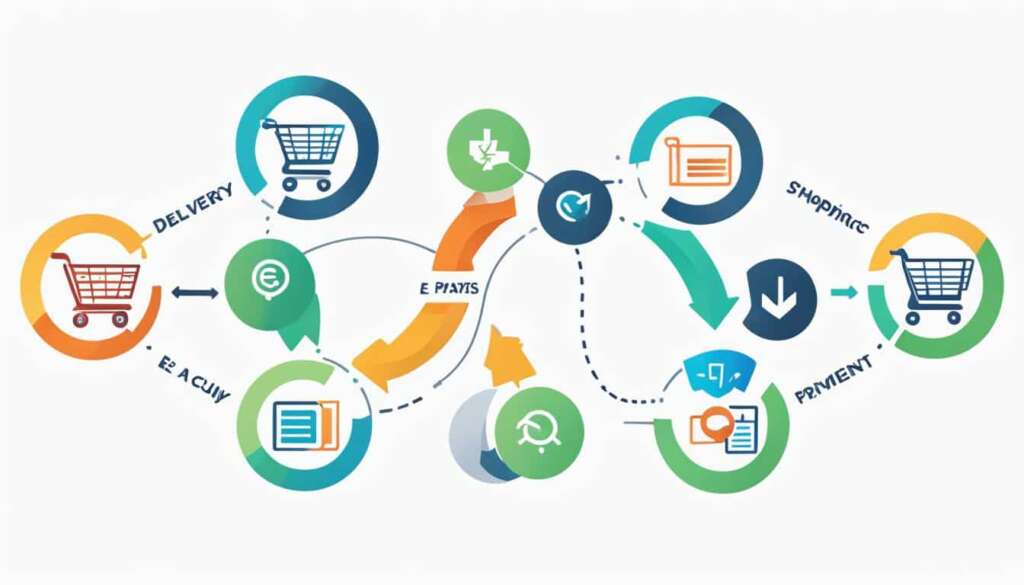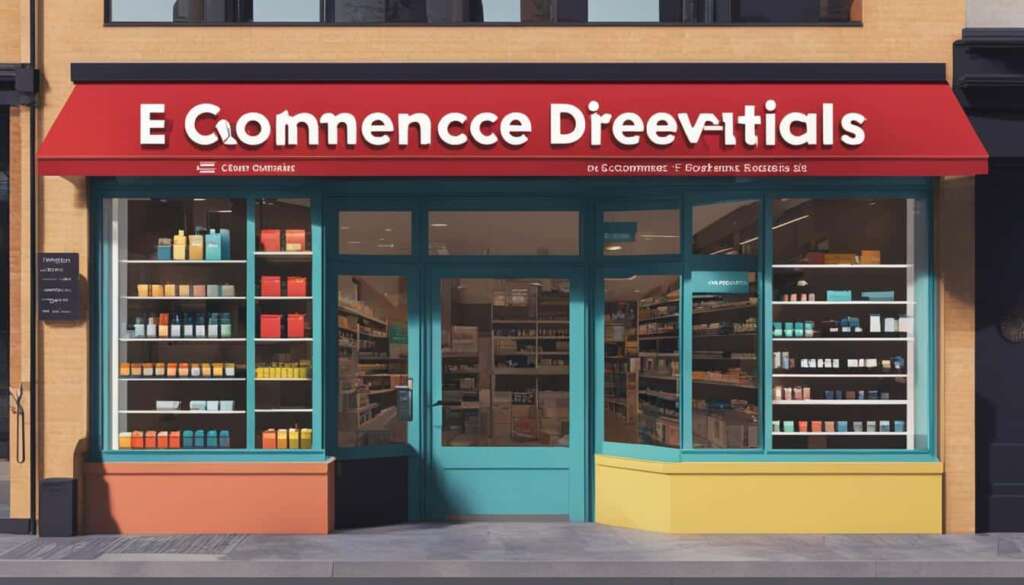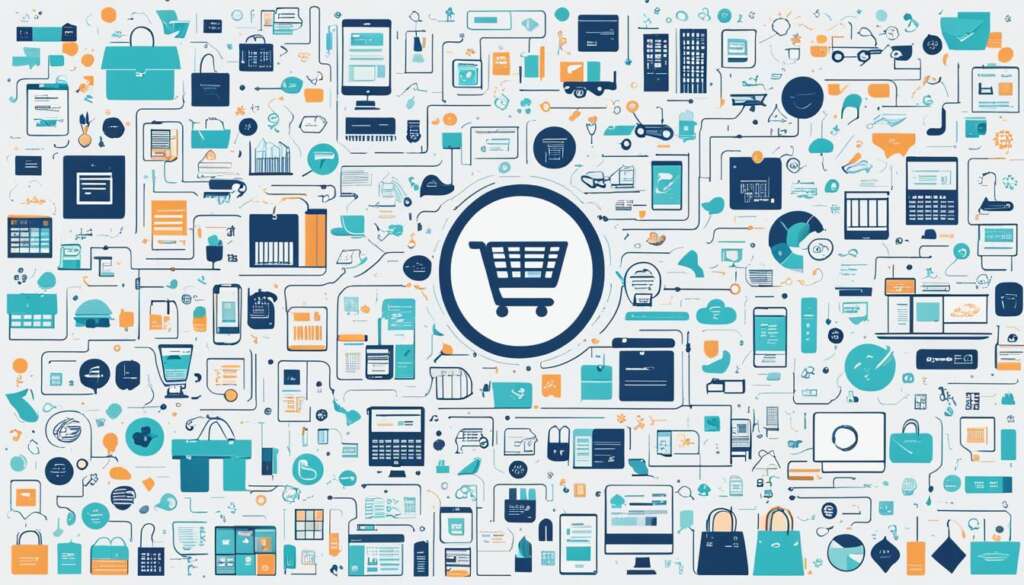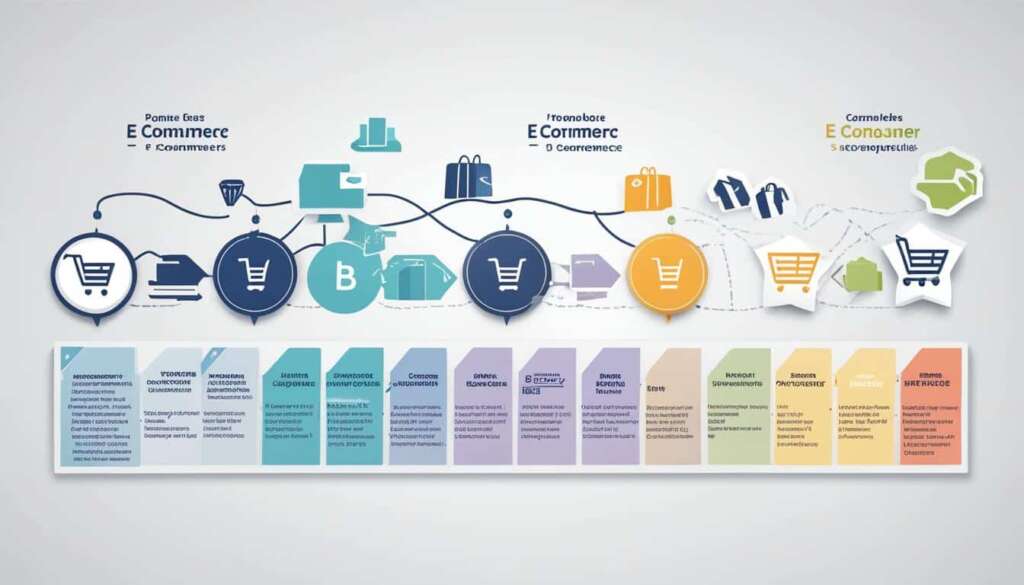Table of Contents
Direct-to-Consumer (DTC) e-commerce has revolutionised the retail landscape, allowing brands to sell directly to consumers without traditional intermediaries. This model has gained significant prominence in recent years, with DTC brands setting the stage for digital innovation and customer-centric experiences. In this article, we will explore the emerging trends and gain expert insights into the evolving direct to consumer e-commerce landscape, providing valuable information for brands to enhance their strategies in this competitive space.
Traditional Retailers Embrace DTC Strategies
Traditional retailers have recognized the success of DTC brands and have started adopting similar strategies to compete in the digital age. By drawing from the DTC playbook, traditional retailers are leveraging technology to attract and retain customers.
“The retail landscape is evolving, and traditional retailers understand the need to adapt. By embracing DTC strategies, they can tap into the growing e-commerce sales and cater to the preferences of today’s consumers,” says Sarah Johnson, retail expert at Market Insights UK.
One notable example of a traditional retailer embracing DTC strategies is Nike. The sportswear giant shifted its focus to DTC sales, resulting in a significant increase in e-commerce sales. By cutting out the middleman and selling directly to consumers, Nike has gained better control over pricing, promotions, and brand image.
This trend indicates that more traditional retailers will follow suit and embrace DTC strategies to meet the demands of tech-savvy consumers. By leveraging their existing brand presence and adopting DTC practices, traditional retailers can tap into the growing e-commerce market and stay competitive in the digital landscape.
Benefits of Traditional Retailers Embracing DTC Strategies
There are several benefits that traditional retailers can unlock by embracing DTC strategies:
- Control over the customer experience: By selling directly to consumers, traditional retailers can have full control over the customer experience, from the moment a consumer lands on their website to the post-purchase journey.
- Better access to customer data: DTC strategies enable traditional retailers to gather valuable customer data, allowing them to understand their target audience better and personalize marketing efforts.
- Improved profit margins: By eliminating the need for intermediaries, traditional retailers can improve their profit margins and reinvest those savings into other aspects of their business.
It is clear that embracing DTC strategies can provide traditional retailers with a competitive edge in the e-commerce landscape. As more consumers shift towards online shopping, traditional retailers must adapt and meet customers where they are.
DTC Brands Expand into New Categories
The COVID-19 pandemic has accelerated certain consumer trends, such as the increased demand for athleisure and self-care products. DTC brands have capitalized on this shift and have expanded into adjacent categories to meet consumer needs. This trend is expected to continue in 2022, as digital native companies identify new opportunities for growth and diversification. By extending their category reach, DTC brands can attract a larger customer base and solidify their position in the market.
DTC brands have recognized the evolving consumer preferences and have strategically expanded into new categories, catering to the rising demand for athleisure clothing and self-care products. Athleisure, which combines athletic and leisurewear, has surged in popularity as people prioritize comfort and versatility in their clothing choices.
Industry leaders, such as Nike and Lululemon, have successfully tapped into this market and experienced significant growth in their athleisure product lines. By leveraging their existing brand reputation and customer loyalty, these DTC brands have seamlessly transitioned into this emerging category, capturing a substantial share of the market.
The expansion of DTC brands into athleisure is a prime example of their agility and ability to adapt to changing consumer preferences. This strategic move has allowed them to capitalize on the athleisure trend and cater to the growing demand for comfortable yet fashionable clothing options.
Similarly, the self-care industry has experienced a significant boom, driven by a desire for mental and physical well-being. DTC brands, such as Glossier and Lush, have successfully ventured into this category, offering skincare, beauty, and wellness products that promote self-care and enhance personal pampering routines.
By expanding into these new categories, DTC brands can target a wider audience and tap into additional revenue streams. This diversification not only allows them to meet the evolving needs of consumers but also strengthens their brand presence and competitiveness in the market.
DTC Brands’ Expansion into New Categories
| DTC Brand | New Category |
|---|---|
| Nike | Athleisure |
| Lululemon | Athleisure |
| Glossier | Beauty & Skincare |
| Lush | Beauty & Skincare |
DTC brands’ expansion into new categories not only reflects their ability to identify and capitalize on consumer trends but also highlights their adaptability and agility in the ever-changing retail landscape. As digital native companies continue to explore untapped opportunities, we can expect to see further expansion into innovative and niche categories, ultimately redefining the boundaries of DTC retail.
Tech-Savvy Consumers Drive DTC Growth
One of the primary drivers behind the remarkable growth of direct-to-consumer (DTC) brands is the increasing number of tech-savvy consumers who prefer the convenience and accessibility of online shopping. These consumers, armed with their smartphones and tablets, have reshaped the retail landscape by shifting their purchasing habits from traditional brick-and-mortar shops to e-commerce platforms.
The COVID-19 pandemic further accelerated this trend, as lockdowns and social distancing measures compelled consumers to spend more time on their devices and less time in physical stores. With restrictions in place, consumers turned to online shopping as a safer and more convenient alternative. This surge in e-commerce sales has been a boon for DTC brands, allowing them to capitalize on the changing consumer behavior and thrive in the digital landscape.
The data from Q3 2021 in the United States highlights the significant growth of e-commerce sales compared to pre-pandemic levels. This indicates the enduring appeal of DTC brands to tech-savvy consumers. As these consumers continue to prioritize online shopping, it is crucial for DTC brands to prioritize and strengthen their online presence, ensuring that their digital platforms are optimized to cater to the needs and preferences of these consumers.
| Key Insights: | 1. Tech-savvy consumers are driving the growth of DTC brands. |
|---|---|
| 2. The COVID-19 pandemic accelerated the shift towards e-commerce. | |
| 3. Q3 2021 witnessed a significant increase in U.S. e-commerce sales. | |
| 4. DTC brands should prioritize their online presence to capitalize on the growth. |
With the continuous advancement of technology and the ever-increasing reliance on digital platforms, tech-savvy consumers will play a vital role in shaping the future of DTC brands. Their preferences and expectations will drive further innovations in the e-commerce space, challenging brands to continually adapt and refine their strategies to meet the needs of this tech-savvy demographic.
Headless Commerce and Enhanced Experiences
The next generation of DTC brands is embracing headless commerce, a forward-thinking approach where the consumer-facing website is decoupled from the e-commerce platform. This separation enables seamless edge acceleration, empowering DTC brands to deliver content swiftly from distributed servers across the globe. By implementing headless commerce, DTC brands can effortlessly optimize their website performance, offering customers an unparalleled browsing experience that is both faster and more personalized.
Headless commerce allows DTC brands to break free from the constraints of a monolithic e-commerce platform. With a simple click of a button, brands can invoke edge acceleration, harnessing the power of distributed servers to enhance their website speed and reliability. This method facilitates the delivery of tailored content, product recommendations, and personalized shopping experiences, contributing to higher customer satisfaction and increased conversions.
“Headless commerce empowers DTC brands to elevate their customer experiences by combining agility, speed, and personalization. By decoupling the front-end and back-end functionality, brands have the freedom to experiment, iterate, and constantly evolve their user interfaces, resulting in seamless experiences that keep customers coming back for more.”
Furthermore, headless commerce unlocks new possibilities for technology vendors to offer innovative solutions to DTC brands at affordable investment levels. With the website and e-commerce infrastructure operating independently, brands have the flexibility to choose the best-in-class solutions for each component, optimizing their technology stack for performance, scalability, and future growth.
To illustrate the benefits of headless commerce in action, consider the following example:
| Traditional Commerce | Headless Commerce |
|---|---|
| Website and e-commerce platform tightly integrated | Separate website and e-commerce platform |
| Constrained by the limitations of the monolithic platform | Flexibility to choose the best solutions for each component |
| Uniform user interface across all devices | Customizable user interfaces tailored to different devices |
| Relies on a single server location | Deploys content from distributed servers for edge acceleration |
| Limited personalization capabilities | Ability to deliver personalized experiences and recommendations |
This table clearly demonstrates the advantages of headless commerce, illustrating how it enables DTC brands to unlock a multitude of benefits, including enhanced user experiences, improved performance, and the flexibility to adapt to changing consumer expectations.

Seamless Experiences with Edge Acceleration
With the deployment of edge acceleration, DTC brands can deliver content swiftly from servers closest to the end-users, significantly reducing latency and buffering times. This enables seamless experiences, where customers can navigate effortlessly through the website, browse products, and make purchases without interruptions or delays. By prioritizing speed and performance, DTC brands can cultivate a positive brand image, foster customer loyalty, and drive revenue growth.
Not only does edge acceleration improve website performance, but it also allows DTC brands to overcome scalability challenges. By serving content from distributed servers worldwide, brands can successfully handle high volumes of traffic without compromising on speed or experiencing downtime. This ensures that customers can access the website at all times, even during peak shopping periods and promotional campaigns.
Embracing headless commerce and harnessing the power of edge acceleration enables DTC brands to differentiate themselves in the competitive e-commerce landscape. By offering seamless experiences, they can captivate customers from the moment they land on the website, providing a compelling reason to choose their brand over competitors.
Returns as a Competitive Service Differentiator
Returns have become a critical aspect of the customer experience in the e-commerce industry. Consumers prioritise retailers who offer free return shipping and a seamless returns process. By upgrading their returns policies and processes, retailers and brands can differentiate themselves from competitors and provide a positive customer experience.
Investing in return processing locations and streamlining refund issuance can help minimise returns in the first place, providing a competitive advantage for DTC brands.
When it comes to e-commerce, returns are no longer seen as just an inconvenience; they are an opportunity for retailers to show their commitment to customer satisfaction. By ensuring that returns are customer-focused and hassle-free, brands can earn the trust and loyalty of their customers, resulting in repeat purchases and positive word-of-mouth.
“Providing a seamless returns process is an essential part of building customer trust and loyalty in the e-commerce space.” – Sarah Smith, E-commerce Expert
Furthermore, a customer-focused returns policy can act as a competitive differentiator for DTC brands. When given the choice between two retailers with similar products and prices, customers are more likely to choose the one that offers a hassle-free returns experience. This customer-centric approach not only increases customer satisfaction but also builds brand reputation and credibility.
The Benefits of Customer-Focused Returns Policies:
- Enhanced customer satisfaction and loyalty
- Positive word-of-mouth and brand advocacy
- Competitive advantage over retailers with subpar returns processes
- Opportunity to minimize returns through improved product descriptions and sizing guides
- Valuable customer feedback and insights for product improvement
By prioritising returns as a customer-focused service, DTC brands can gain a competitive advantage and position themselves as leaders in the industry. It is not enough to simply offer a return policy; retailers must go the extra mile to ensure a seamless and convenient returns process that exceeds customer expectations. Investing in technology, logistics, and customer support to facilitate returns can deliver long-term benefits and contribute to the overall success of a DTC brand.
D2C Model Benefits for Manufacturers and Retailers
The Direct-to-Consumer (D2C) model presents several benefits for both manufacturers and retailers. By embracing D2C strategies, brands can unlock a range of advantages that contribute to their success in the digital marketplace.
1. Faster Customer Reach
By adopting a D2C approach, manufacturers and retailers can establish a direct connection with customers, eliminating the need for traditional intermediaries. This direct interaction enables brands to bring their products to market more swiftly, bypassing distribution delays and reaching consumers in a shorter time span.
2. Better Access to Customer Data
The D2C model empowers brands with enhanced access to valuable customer data and insights. By selling directly to consumers, manufacturers and retailers can gather information such as purchase history, preferences, and demographics. This data, when analyzed appropriately, enables brands to create personalized marketing campaigns, tailor their product offerings, and build stronger customer relationships.
3. Control Over the Customer Experience
One of the key benefits of the D2C model is the ability for brands to have full control over the customer experience. By directly engaging with customers, manufacturers and retailers can shape every touchpoint, from pre-purchase interactions to post-sales support. This control enables brands to deliver a consistent and seamless experience, fostering customer loyalty and satisfaction.
4. Improved Profit Margins
Implementing a D2C model often leads to improved profit margins for manufacturers and retailers. With the elimination of intermediaries, brands can capture a larger portion of the revenue generated by each sale. Additionally, the ability to set their own pricing and promotions allows brands to maximize profits and adapt to market fluctuations more effectively.
5. Price, Promotion, and Brand Image Control
D2C models grant manufacturers and retailers greater control over critical aspects such as pricing, promotions, and brand image. Brands can establish their positioning in the market, communicate their unique selling proposition, and maintain consistent pricing strategies. This control allows for agility in responding to market trends and consumer demands, giving brands a competitive edge.
“The D2C model offers manufacturers and retailers the opportunity to establish direct connections with customers, gain valuable insights, and maintain control over the customer experience. By embracing this model, brands can achieve faster market reach, improve profit margins, and shape their brand image in a highly competitive e-commerce landscape.”
Manufacturers and retailers are increasingly recognizing the potential of D2C models and incorporating them into their long-term strategies. By leveraging the benefits of the D2C model, brands can thrive in the evolving e-commerce landscape, gaining a competitive advantage and driving growth.
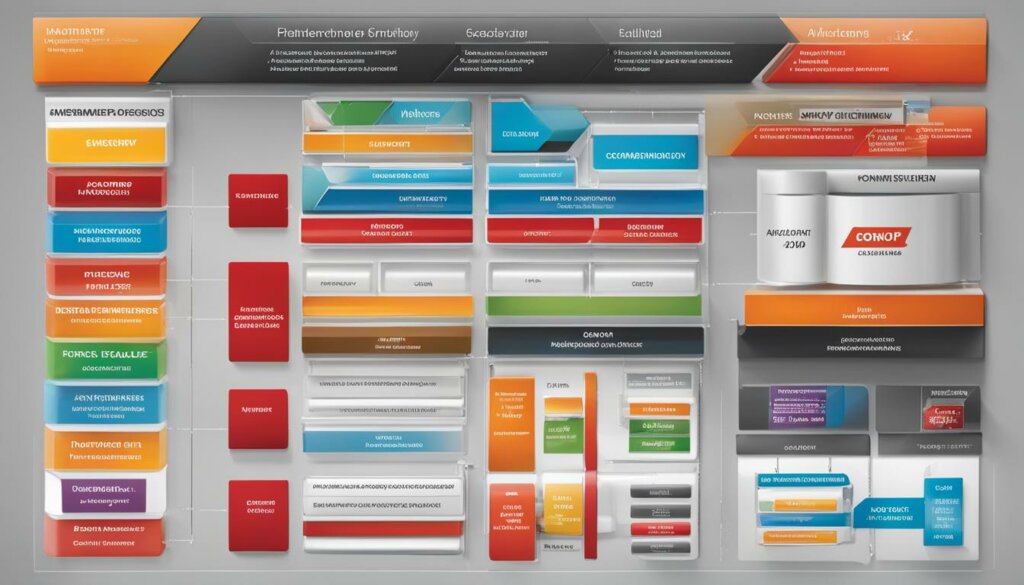
Conclusion
Direct-to-consumer e-commerce has revolutionized the retail landscape, presenting brands with new opportunities and challenges. As traditional retailers embrace DTC strategies, they are able to tap into the power of digital innovation and compete in the ever-changing market. At the same time, DTC brands are expanding into new categories and meeting the demands of tech-savvy consumers.
Headless commerce and enhanced experiences are transforming the way brands engage with their customers, providing faster and more personalized interactions. Returns have also become a crucial aspect of the customer experience, and retailers who prioritize seamless returns processes position themselves as competitive leaders.
Manufacturers and retailers alike are recognizing the benefits of adopting D2C models, such as gaining better access to customer data and having more control over the customer experience. To navigate the evolving DTC landscape successfully, brands must stay informed about key industry trends and incorporate them into their future strategies. By doing so, they can enhance profitability and achieve long-term success in the dynamic world of e-commerce.
FAQ
What is direct-to-consumer e-commerce?
Direct-to-consumer (DTC) e-commerce is a business model that allows brands to sell their products directly to consumers without traditional intermediaries, such as retailers or wholesalers.
Why are traditional retailers embracing DTC strategies?
Traditional retailers have recognized the success of DTC brands and are adopting similar strategies to compete in the digital age. By leveraging technology and focusing on DTC sales, retailers can attract and retain customers in an increasingly competitive market.
How are DTC brands expanding into new categories?
DTC brands are capitalizing on consumer trends, such as the increased demand for athleisure and self-care products, by expanding into adjacent categories. This allows them to meet evolving consumer needs and attract a larger customer base.
What is driving DTC growth?
DTC growth is being driven by tech-savvy consumers who prefer the convenience of online shopping. The COVID-19 pandemic has further accelerated this trend, with consumers spending more time on their devices and less time in physical stores.
What is headless commerce?
Headless commerce is a technology architecture where the consumer-facing website is separate from the e-commerce platform. This allows DTC brands to serve content from distributed servers worldwide, providing faster and more personalized experiences for customers.
How can returns be a competitive service differentiator?
Returns have become a critical aspect of the customer experience in the e-commerce industry. By offering free return shipping and streamlining the returns process, brands can differentiate themselves from competitors and provide a positive customer experience.
What are the benefits of the D2C model for manufacturers and retailers?
Adopting the direct-to-consumer (D2C) model provides several benefits for manufacturers and retailers, including faster access to customers, better control over the customer experience, and improved profit margins. D2C also allows brands to bypass traditional distribution partners, giving them more control over pricing, promotions, and brand image.



